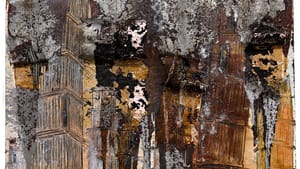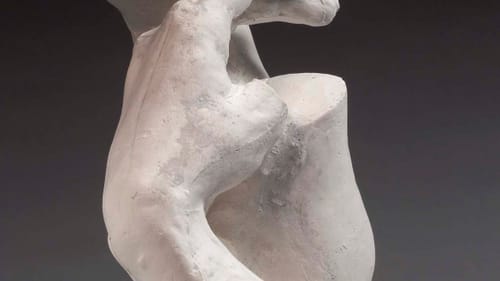Stay in the Loop
BSR publishes on a weekly schedule, with an email newsletter every Wednesday and Thursday morning. There’s no paywall, and subscribing is always free.
Contemporary interpretation meets artistic inheritance
Barnes Foundation presents 'Kiefer Rodin' (second review)

Philadelphia is the U.S. center of worldwide celebrations commemorating Auguste Rodin on the centenary of his death. The city’s abundant permanent collection, including more than 140 pieces held by the Rodin Museum, will be enhanced with the opening of Kiefer Rodin at the Barnes Foundation.
Kiefer Rodin combines Rodin watercolors, drawings, and sculptures with responding work by contemporary artist Anselm Kiefer. The exhibition, a collaboration between the Barnes and Paris’s Musée Rodin, which initiated the worldwide commemoration, examines Rodin’s continuing influence through the work of Kiefer, who was given rare access to archival materials.
Though they never met (Kiefer was born almost three decades after Rodin died), the contemporary painter and sculptor spent the last few years in conversation with Rodin’s work, exploring storerooms at Musée Rodin, and considering his entire artistic output. The opportunity inspired Kiefer, and Rodin becomes newly present, viewed through Kiefer’s work.
Discovering Rodin in the studio
The artist Kiefer encountered is different from the Rodin who museum visitors know. Kiefer met experimental Rodin, who cast rows of small body parts to test positioning and musculature (Spare Arms, Hands, and Bones, and Spare Heads and Feet, both undated). The studio work, as well as travel journals and sketchbooks, are on view in the exhibition, much of it for the first time in the United States.
The show opens with a gallery devoted to Rodin watercolors, drawings, and sculptures. A second gallery holds Kiefer paintings, watercolors, pencil drawings, and vitrines, glass-encased assemblages of casts, molds, and other materials. The rooms are linked by Kiefer’s representation of the creative DNA they share, A.R.A.K. (2017), a 13-foot-high, earth-toned canvas adorned with side-by-side double helixes.
Shared themes
Both artists merge architecture and anatomy. Rodin combined the two in his consideration of French cathedrals, which he believed were vessels of Gallic history and cultural identity.

Several works on view demonstrate this, including pencil sketches in which a column transforms into an upright woman with hands behind her head, her pointed elbows mirroring the column’s Ionic capital. In Torso of Adèle, a fragment of Rodin’s Gates of Hell (1890-1900), the woman has become part of the capital, while the beautiful sculpture The Cathedral (1908) creates a sanctuary between two right hands poised to grasp each other.
Cathedrals of France (1914), Rodin’s only book, resonated with Kiefer, who echoes and enlarges on the iconography in a watercolor series, Les Cathédrales de France (2013), and painting series, Auguste Rodin: les Cathédrales de France (2016). In the large paintings, Kiefer layers clay, metal, plaster, lead, and zinc over a cathedral’s face. The layers curl away from the canvas like pages of a book, or history unfolding.
In The Consciousness of the Stones (2014) and Marble Cliffs (2014), delicate watercolor and pencil works, Kiefer feathers human forms into the grain of marble slabs: lithe dancers, crouching women, sleeping giants.
Repairing the past
Rodin intended Cathedrals of France to renew appreciation of the structures among the French, believing them vessels of national history and cultural identity. Kiefer, born in Germany in 1945, came of age in a country devastated by war, haunted by the disgrace of the Third Reich and Nazism, and at risk of having its cultural heritage subsumed in postwar shame.
He became interested in Germany’s forbidden topics and the destruction of its culture. His sculptures are large, layered, and architectural, not unlike the skeletal remains of bombed-out postwar cities. Yet because Kiefer did not directly experience the war, he can dispassionately examine the ruins, the silence, and the brokenness. As a young artist in the 1960s, he photographed himself in different locations giving the Nazi salute; the Occupation Photos made people nervous, critics included.
Kiefer is said to never consider a work “finished” and discards nothing as he creates. In the 2014 documentary Remembering the Future, he hacks at a canvas so thickly layered with paint it resembles the bark of an ancient tree. Dried crusts of paint fly off as he whacks away. The image changes, but only he will know when it is right. Bits and pieces are saved for reuse, to be transformed in a future work.
Kiefer’s policy of recycling trimmings and edits is evident in works that incorporate straw, lead, even burned paper and ash. Similarly Rodin, in his studio, saved discarded bits for reassembly. These practices hint at the value each artist places in the past and its potential to inform the future.
Philadelphia’s Rodin perspective
Philadelphia played a crucial role in Rodin’s career. The artist received his first American exposure here, at the 1876 Centennial celebration, and a 1905 Pennsylvania Academy of Fine Arts exhibition lent stature to his growing reputation. So it is only fitting that Rodin’s ongoing influence be explored here.
The Barnes is ideally suited for Kiefer Rodin, not only because it neighbors Philadelphia’s Rodin Museum but because of the nature of the exhibition, which, like the Barnes, acknowledges that artistic sensibility is not organized into separate eras and styles but flows freely through the human experience.
To read Stacia Friedman's review, click here.
What, When, Where
Kiefer Rodin. Through March 12, 2018, at the Barnes Foundation, 2025 Benjamin Franklin Parkway, Philadelphia. (215) 278-7000 or barnesfoundation.org.
Sign up for our newsletter
All of the week's new articles, all in one place. Sign up for the free weekly BSR newsletters, and don't miss a conversation.